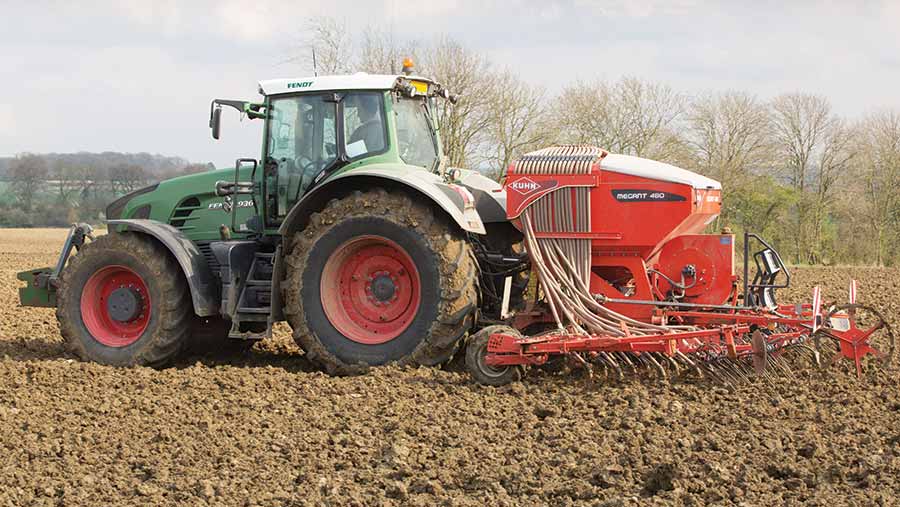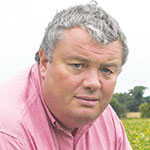Crop Watch: Wet Easter adds to massive field work backlog
 © Tim Scrivener
© Tim Scrivener Spring drilling is at a standstill in the sodden fields and our agronomists are considering the implications of a delayed T0 fungicide wheat, as sprayers are unable to travel.
There is a growing risk that T0 fungicides will be delayed in early-drilled, which Association of Independent Crop Consultants agronomist Stephen Harrison has renamed “T nought a chance”.
See also: How one Maris Otter grower hopes to grow a 7t/ha crop
All agree that crop growth and septoria will surge ahead this month once things warm-up. Farmers face many tough choices in the coming days, as they prioritise the tasks that all need doing at the same time.
South: Iain Richards
Agrii (Oxfordshire)

Iain Richards
April has arrived and barely 10% of our spring crops are in, most of our winter cereals have only just received their first nitrogen, and both wheat T0 and oilseed rape stem extension spraying is imminent.
So it’s a matter of being brutal with our priority setting and making every available extended working hour count while accepting more mess than we’d like in the tramlines.
Thankfully, the spring has remained cold as well as very wet. This means our winter wheats have yet to get near growth stage 30 and the oilseed rapes are only just starting to extend. Neither are carrying rampant disease.
Although spring drilling is our top priority, patience is every bit as important since the very last thing late-drilled crops need is a poor start.
Once conditions come right, we will be sowing our spring barleys at a good 400 seeds/sq m to compensate for their shorter growing season.
Mauling crops
But the one thing we won’t be doing is mauling-in late April crops. It simply isn’t worth it.
If we have to sow less than we want to, we’ll use the opportunity to improve weed control, add organic manures and get the best possible entry for autumn drilling.
With winter keeping a firm lid on wheat development and disease, we won’t rush into our T0s either.
Both crop growth and septoria will surge ahead in April once things warm-up.
But holding off on a decent T0 until leaf four is fully emerged will ensure the greatest protection and a good short interval to T1 so we stay firmly in the disease management driving seat.
Nor should a slightly later T0 hurt in growth regulation – providing we use a growth regulating active at the continuing low soil temperatures.
Oilseed rape extension spraying is definitely lower down our immediate batting order. Some of the evenest we’ve ever seen, most of our crops are well rooted. They only got their first N in early March, are yet to romp away and remain very clean.
Winter has done a good bit of growth regulation for us and we have plenty enough opportunities for extra canopy manipulation – and foliar feeding – in our flowering as well as stem-extension sprays.
East: Sean Sparling
AICC/SAS Agronomy (Lincolnshire)
 March came in like a lion and went out like a sea lion, 64mm of rain and dry on just four out of 31 days.
March came in like a lion and went out like a sea lion, 64mm of rain and dry on just four out of 31 days.
This has further complicated an already untidy Lincolnshire spring. Fields drilled with beans, peas or linseed are a rarity due to conditions only suitable for rice propagation and can be counted on the fingers of one foot.
Of less concern, considering our outstanding drilling workload, not a single field of sugar beet has been drilled, but then this can wait.
Spring barley/wheat drilling is proving to be a real challenge and, with the forecast looking similarly wet, an end to the cereal drilling season seems an awfully long way off.
On a more positive note, the oilseed rape is running, having finally received its first nitrogen.
Oilseed rape
It looks remarkably fit and well, where the pigeons have left it alone, but the warm weather during the fourth week has encouraged the light leaf spot to get going too. Therefore, fungicides are being applied as and where the need arises and as the rain allows.
Septoria tritici is widespread on the older leaves of almost all wheat varieties out there and, with soils finally warming up, the septoria and yellow rust are stirring.
As a result, the T0 fungicide recommendations are queued up and awaiting application on many farms, all being necessarily loaded with the vital multisite chlorothalonil.
It is notable that where winter wheats have been sat in wet soils for the past 10 weeks, they’ve suffered the loss of the bulk of their fibrous roots as a result.
Therefore, the inclusion of manganese, strobilurins or plant growth regulators with the T0 fungicide can encourage the plant to develop more vital hunger roots, which in turn will allow stressed plants to access those crucial soil nutrients.
West: Stephen Harrison
AICC/Southwest Agronomy (Avon)

Stephen Harrison
Apologies for stating the blindingly obvious, but the rain continued through late March. Field work is at a virtual standstill with only a handful of the very lightest fields drilled into spring crops.
In spells such as this, the watchwords must be patience and priorities.
Spring crops established well in good seed-beds in mid-April will not be a disaster. I rather suspect when the weather does improve spring crop drilling will be the focus.
One of my main concerns is contact blackgrass herbicides on wheat. If you have these to apply, forget about T0 (now renamed T nought a chance) and get them on.
Do not be tempted to mix delayed mesosulfuron-based treatments with chlorothalonil, any hope of successful control will be reduced.
Yellow rust levels are very low and response to septoria control from treatments before final leaf three is limited. Far better to beef up the final leaf three treatment, slow growth in the cold means that each leaf will be exposed to infection for longer.
Barley fungicide
With winter barley the early stem extension fungicide is vital. If spraying opportunities occur this should be acted upon.
Similarly, important are oilseed rape treatments with picloram/clopyralid for cleavers, mayweeds and thistles. Pay attention to sprayer hygiene when moving from cereal sulfonylureas to oilseed rape, the consequences can be severe.
The flower buds must not be visible above the leaf cup to apply these products.
Where already applied they have been tank mixed with light leaf spot fungicides. A far smaller proportion of fungicides with growth regulatory effects have been employed.
Oat crops remain at late tillering and look clean apart from a few cleavers and speedwells. Winter beans are moving slowly and really do need some warmer weather. At least the chilly weather is stopping any weevil attack.
North: Andy Goulding
CAS/Hutchinsons (Cheshire)

Andy Goulding
The flurry of activity that swept across the North West has come to an end with the thoroughly miserable weather we’ve had over Easter and the days that followed.
Thankfully, most crops have had a dose or two of fertiliser, though I’m not expecting them to win top prize for utilisation percentage. The weather is adding complexity to agronomy and opportunities have to be grabbed and priorities rethought.
T0 is days away on the most forward crops – will the ground be in a condition farmers will be prepared to travel on? We all know little direct yield benefit can be had when targeting septoria at this timing. However, in the wet West, it can help in the event of a delayed T1.
What we shouldn’t forget are the other jobs we do at this time, growth regulation/manipulation, and trace element nutrition, which have great importance in building harvestable yield.
Micronutrient deficiencies
Few of us will be surprised by manganese cropping up as low in recent tissue analysis of cereal crops, but boron has also been identified in numerous occasions as being low. The sooner potential yield-limiting factors can be identified and understood, the quicker we can act and rectify without too much off-piste work.
Oilseed rape is continuing to make progress at green bud and many crops are carrying a lot of disease. This will need addressing as soon as possible, most likely with prothioconazole.
Precious few spring crops have been planted and none established. Seed rates will need to be reviewed and stocks perhaps prioritised in some areas – at the expense of not drilling others that won’t contribute to profit.
From our own trials we have seen establishment as low as 50% on heavy soils, which is a difficult number to swallow, but could be common place this season.

